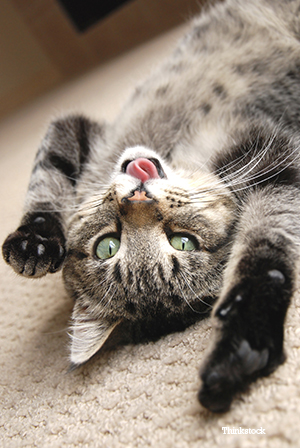As more and more cats live exclusively indoors (where they’re safest) more and more are also using the litter box. One of the best things about a litter box is that it allows you to be more aware of your cat’s urine habits. You may notice, for example, that you’re cleaning the box more often.
[Learn all about the diagnostic value of a litter box here.]
If there is more urine in the litter box, it can sometimes be a bit difficult to tell if a cat is peeing larger volumes or just more often; however, it’s important to differentiate increased frequency from increased volume, since they indicate completely different potential problems and point to different locations in the urinary system. There are conditions that cause increased frequency of small amounts of urine, conditions that result in large volumes of urine and conditions that cause increased attempts to urinate. You may need to keep a close eye on your cat to know for sure.
It will also be important to know what is normal for your cat so that changes will be noticeable. One study, reported by DVM 360, indicated that cats produced an average of 28 ml/kg of urine every 24 hours. That equals about one half cup of urine a day for the average 10 pound cat. In general, what goes in must come out. Although minute water losses include tear flow, saliva flow and fluids contained in stools, the majority of water leaves the body of animals as urine.
Is your cat peeing a lot or just often?
Increased urine frequency (pollakiuria): If your cat is urinating small volumes frequently, he is not peeing too much; in fact, he may not be peeing enough. This condition is called oliguria and refers to decreased urine formation by kidneys or decreased elimination of urine from the body. Voiding frequent, small volumes is most often a sign of bladder irritation associated with sterile, idiopathic inflammation, infection, bladder stones or obstruction. Alternatively, increased frequency of a normal volume or increased attempts to urinate are serious signs of urinary problems, indicating possible inflammation or a sense of urgency associated with an inability to empty the bladder because of some form of blockage. Oliguria associated with decreased urine formation by the kidneys may be in compensation for bodily fluid losses elsewhere or it may be pathologic, but is always significant. These conditions should be treated as an emergency and must be evaluated by a veterinarian as soon as possible.
Increased volume (polyuria): If your cat is urinating larger than normal volumes, it’s called polyuria. Most of the time excessive urinating is a result of the body’s inability to regulate urine formation. Excess blood glucose, for instance, leaves the body through urine and carries a lot of water with it. Kidney disease often results in an inability to retain fluids and so urine forms more rapidly than normal. Some hormonal diseases such as diabetes or hyperthyroidism result in poor urine concentrating ability, causing too much water to be excreted as urine. Whatever the cause, the result is increased water intake in an effort to balance this excess urine output.
How will my veterinarian decide why my cat is peeing excessively?
Your veterinarian will always start with a thorough physical examination, but blood and urine tests are needed to evaluate organ function.
What should I do if my cat seems to be peeing more than usual?
These conditions are always serious and can be life threatening. The sooner your cat is diagnosed, the greater the chances of success. See your veterinarian at once!
Also check out:
- Kidney Disease in Cats 101
- Chronic Kidney Disease: What Does Kidney Failure in Cats Really Mean?
- 5 Things Vets Hate About Kidney Disease in Cats … And How That’s About to Change
If you have any questions or concerns, you should always visit or call your veterinarian -- they are your best resource to ensure the health and well-being of your pets.
